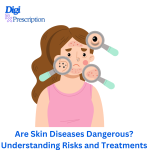
Skin diseases affect millions of people worldwide, ranging from mild conditions like acne to life-threatening diseases like melanoma. While some skin conditions are harmless and temporary, others can lead to severe complications, organ damage, or even death if left untreated. In this article, we explore the most dangerous skin diseases, their risks, and treatment options.
When Can Skin Diseases Be Dangerous?
Skin diseases become dangerous when they:
✅ Spread rapidly (e.g., infections)
✅ Cause systemic illness (e.g., lupus, skin cancer)
✅ Lead to severe pain, scarring, or disfigurement
✅ Affect internal organs or the immune system
Dangerous and Life-Threatening Skin Diseases
1. Skin Cancer (Melanoma, Basal Cell Carcinoma, Squamous Cell Carcinoma)
Skin cancer is one of the most deadly skin diseases, especially melanoma, which can spread to internal organs.
Symptoms: Unusual moles, dark patches, sores that don’t heal.
Treatment: Surgery, chemotherapy, immunotherapy, radiation therapy.
???? Reference: Skin Cancer Foundation
2. Toxic Epidermal Necrolysis (TEN) & Stevens-Johnson Syndrome (SJS)
These rare but life-threatening allergic skin reactions cause the skin to peel off in large areas.
Causes: Severe drug reactions (antibiotics, NSAIDs, anticonvulsants).
Symptoms: Painful rash, blisters, fever, peeling skin.
Treatment: ICU care, stopping the offending drug, wound care.
???? Reference: Mayo Clinic
3. Necrotizing Fasciitis (Flesh-Eating Disease)
A rare bacterial infection that destroys skin, fat, and muscle tissue.
Causes: Bacteria like Streptococcus enter through cuts or wounds.
Symptoms: Intense pain, redness, swelling, fever, blackened skin.
Treatment: Emergency surgery, antibiotics, possible amputation.
???? Reference: CDC - Necrotizing Fasciitis
4. Systemic Lupus Erythematosus (SLE)
Lupus is an autoimmune disease that affects the skin, joints, and internal organs.
Symptoms: Butterfly-shaped rash, joint pain, fatigue, kidney problems.
Treatment: Immunosuppressants, corticosteroids, lifestyle management.
???? Reference: Lupus Foundation of America
5. Bullous Pemphigoid
A rare but severe autoimmune blistering disorder that can lead to infections and sepsis.
Symptoms: Large, fluid-filled blisters on the skin.
Treatment: Corticosteroids, immunosuppressants, antibiotics.
???? Reference: National Organization for Rare Disorders (NORD)
Common Skin Diseases That Can Become Dangerous If Left Untreated
Some non-life-threatening skin diseases can become serious if ignored:
Psoriasis → Can lead to psoriatic arthritis and heart disease.
Eczema (Atopic Dermatitis) → Can cause secondary bacterial infections.
Ringworm & Fungal Infections → Can spread to deeper tissues.
Severe Acne → Can cause permanent scars and mental health issues.
Lice & Scabies → Can cause chronic itching, infections, and social stigma.
When to See a Doctor for a Skin Condition?
Seek immediate medical attention if:
???? Skin condition is spreading rapidly.
???? Pain, fever, or severe discomfort occur.
???? Skin becomes blackened or necrotic.
???? Blisters or ulcers appear suddenly.
???? Moles or lesions change in shape, size, or color.
Conclusion
While not all skin diseases are dangerous, some can lead to serious health complications if ignored. Early diagnosis and treatment can prevent severe outcomes. Always consult a dermatologist if you notice sudden, painful, or unusual skin changes.
Would you like me to add home remedies or prevention tips for skin diseases? ????
Here are the references for the blog post on "Are Skin Diseases Dangerous? Understanding Risks and Treatments":
Skin Cancer Foundation
Information about skin cancer types, risks, and treatments.
Website
Mayo Clinic
Provides in-depth information on Toxic Epidermal Necrolysis and other rare skin diseases.
Website
Centers for Disease Control and Prevention (CDC)
A reliable source for necrotizing fasciitis (flesh-eating disease) information, including causes, symptoms, and treatment.
Website
Lupus Foundation of America
A trusted organization offering resources on systemic lupus erythematosus (SLE), its impact on skin, and treatment options.
Website
National Organization for Rare Disorders (NORD)
Provides information on Bullous Pemphigoid, a rare autoimmune blistering disorder.
Website
American Academy of Dermatology (AAD)
Offers information about various skin conditions, treatments, and preventive measures.
Website
These sources provide comprehensive details on various skin conditions and treatments, helping readers understand the severity of certain diseases.
